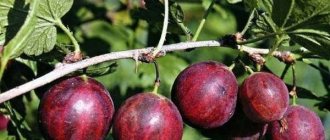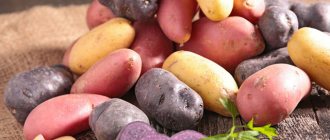Characteristics of the Kolobok potato variety
The yellow-fruited variety is characterized by medium ripening periods. The tubers, with their characteristic rich yellow flesh and skin, have a slightly elongated round shape with pronounced but shallow eyes. The skin is very dense, so the crop can be stored for a long time and transported over long distances without loss. Photos and descriptions of the Kolobok potato variety indicate that this is a very attractive crop that is in high demand among ordinary gardeners and farmers who grow vegetables for sale.
The average weight of potatoes is 120-140 g. They ripen from the moment of planting in 90-115 days. 1 potato bush of the Kolobok variety produces an average of 15-18 tubers. The tops do not stretch upward too much. The crown is formed semi-erect. The leaves are usually medium in size, sometimes large, and light green in color. Flowering is usually abundant, the flowers are very light - larger than usual. A distinctive feature is the evenness of the tubers in relation to each other; very few non-marketable potatoes of irregular shape and too small size grow.
Features of growing in harsh conditions
Rows of potato bushes
In more severe conditions, it is necessary to bury the tubers to a depth of no more than 5-10 cm. In this position, the potatoes will be able to germinate in a warm layer of soil and ripen by August. The soil in such regions warms up slowly, so tubers planted at great depths will not have time to grow a large bush during the growing season, bloom and form a sufficient number of tubers of standard size. An increase in yield in such conditions is achieved through hilling and fertilizing, carried out at the end of June or at the beginning of July.
The rows of bushes are placed at a distance of 50-60 cm. An interval of at least 30 cm is formed between the bushes in the row.
Hilling is carried out in 2 stages. The first time they hill up when the shoots are 25 cm. The second time it is necessary to rake the earth around the bushes 20 days after the first time.
Before planting, complex mineral fertilizers with equal amounts of nitrogen, potassium, and phosphorus are placed in holes or trenches. Complex fertilizers are applied at the rate of 25 g per hole. Instead of fertilizers, you can add humus and wood ash (1 handful per hole).
With fertile soil, there is no need for fertilizing. It is enough to monitor the correct humidity regime. This variety does not tolerate drought. If overwatered, the tubers may begin to rot. After the potatoes bloom, the intensity of watering is reduced. High humidity promotes the development of late blight .
Tall stems of bushes need constant good lighting, so they need to be placed in the north-south direction. Otherwise, the shoots will begin to stretch due to lateral shading.
Taste qualities of potatoes
Consumers rate the taste of Kolobok potatoes as pleasant. According to reviews, it is good for chips and French fries. If we are talking about processing large volumes of tubers, then they are more often used to produce dry puree and frozen vegetable mixtures. The starch content typical of the Kolobok potato variety is no more than 15%. In general, the purpose is universal. When cooked, the pulp usually does not darken, does not boil too much, remaining dense. Therefore, it is recommended to fry the tubers.
Excellent reviews and characteristics of the Kolobok potato variety have made it a real bestseller. The demand for its seeds is very high.
Pros and cons of the Kolobok potato variety
Among the advantages of the Kolobok variety:
- delicate taste;
- keeping quality;
- stable yield;
- unpretentiousness to growing conditions;
- versatility of use;
- resistance to diseases.
The only drawback that can be noted is the need for watering. In the absence of the required amount of moisture, the yield of the Kolobok potato variety can fluctuate by almost 2 times. They also note a very dense peel, which is more difficult to cut off during peeling than other varieties. This is invariably noted when describing Kolobok potatoes, because hard skin is a distinctive feature of potatoes harvested by mechanization.
Origin
Kolobok is an officially approved variety. It was registered in the State Register in 2005. Initially, it was created for the conditions of the European part of Russia, or more precisely for the Central and Central Black Earth regions. Grown outside these areas.
Advertisements
The official characteristics of the Kolobok potato and description of the variety were formed at the Institute of Potato Farming named after. Lorja. Here Kolobok was created and brought to a genetically stable state.
Planting and caring for Kolobok potatoes
The optimal planting time is in the first ten days of May. The main condition is that the soil has completely thawed and warmed up to at least + 10 0C.
Selection and preparation of a landing site
Areas for potato planting have been prepared since the fall. Carefully remove all plant debris and roots of perennial weeds. If potatoes have already been planted in a given area this year, it is not recommended to use them for this next year. Crop rotation is at least 3 years. Optimal predecessors are legumes, cruciferous vegetables and spicy greens.
When digging up a site in the fall, organic fertilizers are added to the soil: mullein, bird droppings, compost. In the spring, the digging is repeated, the soil is harrowed, and a portion of complex mineral fertilizer or well-rotted manure is added. Then the rows are marked.
Preparation of planting material
Tubers for planting must not only be well dried and free from traces of diseases, mold, and fungi, but also be pickled. If there is a delay in sowing due to weather conditions, it is recommended to treat the planting material with a growth stimulant. A week before the expected planting date, the boxes with tubers are placed in a warm place to stimulate the growth of shoots from the eyes. The sprouts should not be too large, as then they will break off when planted.
Landing rules
The following planting scheme is recommended for the Kolobok potato variety:
- 60 cm between rows;
- 30 cm between individual bushes.
It is best to orient the rows from north to south to provide the plantings with optimal illumination. Along with each tuber, it is recommended to throw in a large handful of wood ash, as well as a handful of manure or compost.
Advice! Experienced gardeners recommend throwing onion peels into the holes to protect Kolobok and other potatoes from the Colorado potato beetle.
Watering and fertilizing
It is recommended to water the Kolobok potato plantings at least once a week. Lack of moisture has a negative impact on crop yields. Can be combined with fertilizing. It is recommended to do them on average 2-3 times throughout the entire season, giving preference to potash ones. Nitrogen fertilizers are abandoned, as they lead to the growth of tops, but not tubers.
The recommendations of gardeners are clear: if there is a choice, then preference should always be given to organic fertilizers. They have a positive effect on the taste of tubers. The use of chemical fertilizers worsens the taste of potatoes.
It is very important to provide watering until the end of flowering. After this, the lack of rain and drought will no longer cause critical damage to the harvest. The Kolobok potato variety invariably pleases with its productivity, but only with sufficient moisture of the plantings from the emergence of seedlings to the forcing of buds.
Loosening and weeding
These events are combined. The frequency of weeding depends on the weed infestation of the area. Typically, the beds are inspected every week, and the rows are weeded if necessary. It is important to prevent the growth of powerful plants (sow thistle, wheatgrass, etc.) with strong roots. They can pierce tubers and significantly spoil the harvest.
Hilling
It is recommended to hill in 2 steps. The first time Kolobok potatoes are spudded when the bushes grow to 20 cm in height. After 3 weeks, the work is repeated again. After each procedure, be sure to carry out abundant watering. It is best when hilling is carried out before flowering, since abundant watering can provoke the appearance of late blight on adult bushes.
Under no circumstances should you refuse hilling. It is a mistake to believe that they are performed only to preserve moisture in the soil. In fact, thanks to this operation, the bushes are formed correctly. If you leave the planting without hilling, the stems will soon fall and may even break.
Some subtleties and features
Otherwise, the growing conditions for the Kolobok variety are no different from the requirements for other mid-season varieties:
- distance between holes and row spacing – 35x60 cm;
- humus and ash are introduced into a hole 10 cm deep;
- for a good harvest, two-time hilling is necessary in standard terms;
- Sprinkling is carried out during the dry period or at the first appearance of potato moth butterflies;
- after flowering, watering is no longer required;
- loosening and regular weeding are strongly recommended as first priority actions.
For reference: You can increase the yield if, immediately after harvesting, you select even and large tubers for seeds and store them separately from the main crop. This will eliminate the risk of potato contamination during joint storage, and will make it possible to delay the renewal date of the seed stock.
If you periodically change the place where potatoes are planted, sowing them after cabbage, radish or dormancy, the yield will further increase.
Diseases and pests
The Kolobok potato variety is resistant to scab, cancer, and viral diseases. Late blight and cyst nematodes are found on bushes. To protect against them, targeted drugs are used. Treatments are carried out once or twice, no more, and no later than 3 weeks before harvest.
The Kolobok potato is defenseless against the Colorado potato beetle. You can use special preparations for it, or if the infestation is not too high, use manual collection of beetles and larvae. They should not be fed to poultry or livestock, only destroyed.
How to care?
Irrigation, fertilization and preventive measures against diseases can begin on the 21st day, when the crop sprouts. In stagnant, dry weather, it is recommended to increase irrigation frequency up to 3 times every 7 days, using at least 3 liters of liquid that has settled in the sun per bush. When the buds appear, the fruits will begin to actively grow. Therefore, it is necessary to pour up to 15 liters of water per week under the bush.
When caring for the crop, while loosening the soil mixture, it will be useful to remove weeds in the form of sow thistle or wheatgrass. After hilling the crop, before flowers appear on it, the plant must be irrigated abundantly. If this procedure is ignored, excessive watering can provoke the appearance of late blight. When forming seedlings, each shrub needs to be fertilized in the form of a mixture of superphosphate and ammonium nitrate.
The procedure should be carried out before rain so that the liquid can deliver fertilizer to the root system. Up to 50 g of this mixture must be placed under each plant. Before the flowering stage begins, the crop will need to be fertilized a second time. To do this, 25 g of nitrophoska and 50 g of superphosphate should be diluted in 12 liters of liquid, pouring this mixture over all the bushes.
How to store Kolobok potatoes
Dry basements are suitable for preserving the potato harvest. Light is not required; it stimulates the greening of tubers and active growth of shoots. Recommended temperature is about + 4 0C, humidity is about 60-70%. The tubers are laid out in wooden boxes. The keeping quality of Kolobok potatoes is very good, thanks to the thick and tough skin. It is perfectly preserved until the next harvest.
The selection of seed tubers is carried out immediately after the crop has been dug up and well dried under a canopy in the fresh air. Small but regularly shaped tubers without mechanical damage or signs of disease are selected for planting.
Excessive humidity and heat have a detrimental effect on stored potatoes. It is recommended to rinse the container in which the crop will be stored thoroughly with a solution of potassium permanganate. You should also make sure that the basement has good ventilation.
Harvest and storage
The Kolobok harvest begins 95–115 days after planting. To dig up root crops, choose a dry and warm day. The collected root vegetables are sorted, discarding spoiled and mechanically damaged vegetables, while sorting them by size. Before moving for storage, potatoes are well dried. For food, smooth and beautiful large and medium-sized potatoes are left, small root vegetables are intended to feed domestic animals (piglets, goats). For planting next year, medium-sized potatoes, even and without flaws, are selected.
Important! It is necessary to inspect the potatoes stored for storage twice a month. If a rotting root vegetable is discovered, it must be removed from storage immediately before the rotting spreads to neighboring vegetables.
No later than a month later, table potatoes must be transferred to a basement or cellar with an air temperature of +10...+12°C and a humidity of about 82%. Root crops intended for seeds are laid out in the sun and dried for a week. Such seed potatoes acquire a green skin color, this is due to the high content of solanine in the skin and pulp. Green seed potatoes acquire a bitter taste, which does not interfere with reproduction, but will prevent rodents from damaging them during storage.
To obtain a good harvest of Kolobok variety tubers, the potato grower needs to provide the field with good care: timely watering, loosening, fertilizing. Potato plantings also need reliable protection from pests and diseases.
Reviews about the Kolobok potato variety
Veronika Igoreva, 44 years old, Voronezh
I have been planting the Kolobok potato variety for many years in a row. I prefer to buy seeds rather than take my own. This way the result is better, but it’s not a fact that he will grow up without diseases. If the seeds are good, then 14 tubers are guaranteed from each bush. At most, I used to collect 18 pieces. Watering is also important, I make sure to water it once a week, otherwise the tops will become skinny and the tubers will become smaller. I recommend this variety as reliable and tasty.
Alexander Ivanchenko, 50 years old, Shakhty
I grow potatoes for sale, so I select varieties meticulously. I take those that are stored well. It is important not only to grow. But also sell. During the season the price is low, but as spring approaches it is different. Kolobok is a variety with excellent keeping quality. It’s spring, and it’s juicy, dense, doesn’t wither or spoil. There are varieties that are more productive, but they are stored worse. That’s why I treat Kolobok very well and advise everyone to plant it.
Nuances of cultivation
Planting is usually carried out in the month of May. The optimal temperature for planting potatoes is at least +9 C. Holes are dug 10 cm deep. The distance between holes is 30-35 cm, between rows is 60-70 cm.
When planting, you can fertilize each hole by introducing wood ash or humus into it.
Experts note that potatoes can be grown in any type of soil, but well-fertilized, light soil is most suitable.
Before planting, the tubers are germinated until sprouts appear that do not exceed 3 cm in length. Then, if you want to get a good harvest, the tubers are pickled and treated with special growth stimulants (although you can do without them).
Approximately 3 months pass after planting potatoes and before harvesting. In some regions that do not have favorable climatic conditions, the ripening period can last 3.5 months.
During the growing season, two hillings are carried out. The first time when the tops have grown by 25 cm, the second time - after 2-3 weeks.
It is also worth noting that Kolobok is very sensitive to fertilizers. An excess of fertilizing leads to the fact that it begins to accumulate nitrates in root crops. Nitrogenous fertilizers have the greatest effect on the crop, so you need to be careful with them.
The variety needs watering. However, it cannot be carried out after flowering, as there is a high risk of tubers becoming infected with late blight.
You can dig potatoes for testing as early as mid-summer. But the peak harvest will be ready only in mid-September.
Alexei.
We plant three varieties Red Scarlet, Kolobok and Udacha. This year we decided to give up Luck. Something small began to grow. Now let's leave two varieties. In terms of taste, of course, Kolobok is far from Red Scarlet, but in terms of yield it is better.
Irina.
Lyudmila Fedorovna.
We plant only three varieties of potatoes: Red Scarlet, Kolobok and Udacha. So, this year we decided to give up Luck. Very small harvest. The remaining two varieties performed quite well. In terms of taste, if you compare Kolobok and Red Scarlet, the first one loses. But again, everyone has their own taste buds. I speak for myself.
Egor.
I plant Red Scarlet and Kolobok. Kolobok is more popular on the market. Personally with us. In terms of culling, Kolobok is also of higher quality.











